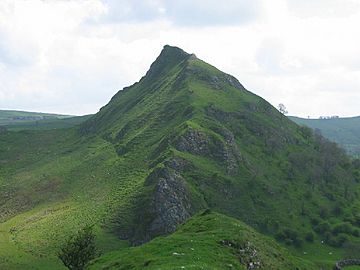Parkhouse Hill facts for kids
Quick facts for kids Parkhouse Hill |
|
|---|---|
 |
|
| Highest point | |
| Elevation | c. 360 m (c. 1,180 ft) |
| Prominence | c. 35 m |
| Geography | |
| Location | Peak District, England |
| OS grid | SK079669 |
| Topo map | OS Landranger 119 |
Parkhouse Hill is a small but very special hill in the Peak District National Park. This beautiful park is located in Derbyshire, England. The hill sits on the north side of the River Dove. It is also very close to the border with Staffordshire.
The Ancient Story of Parkhouse Hill
Parkhouse Hill has an amazing geological history. It is actually what remains of an ancient atoll. An atoll is like a ring-shaped coral reef. Scientists believe this reef existed during the Carboniferous period. This was a time when the area we now call the Peak District was covered by a warm, tropical sea.
Parkhouse Hill and its neighbour, Chrome Hill, are very important. They form a special area called the Chrome and Parkhouse Hills SSSI. SSSI stands for Site of Special Scientific Interest. These sites are protected because of their unique geology and the special plants that grow on their limestone.
Exploring Parkhouse Hill
For many years, it was hard for people to reach the top of Parkhouse Hill. There was no official path or 'right of way' to the summit. But things changed thanks to a law called the Countryside and Rights of Way Act 2000.
Now, the hill is a designated 'access area'. This means people can legally walk and explore the hill. It's a great place for hikers and nature lovers to visit.
The Mysterious Double Sunset
Parkhouse Hill is famous for a very unusual event: the double sunset. In 1997, a writer named Jeff Kent discovered this phenomenon. He noticed that the sun seemed to set twice when viewed from a nearby place called Glutton Grange.
Two years later, in 1999, photographer Chris Doherty captured it on film. This amazing event can be seen in good weather during late March, early April, and September. The sun sets just south of the hill's peak. Then, it seems to reappear almost immediately from the hill's steep northern slope. After fully showing itself again, it sets for a second and final time at the bottom of the hill. Jeff Kent describes this unique event in his book, The Mysterious Double Sunset.

